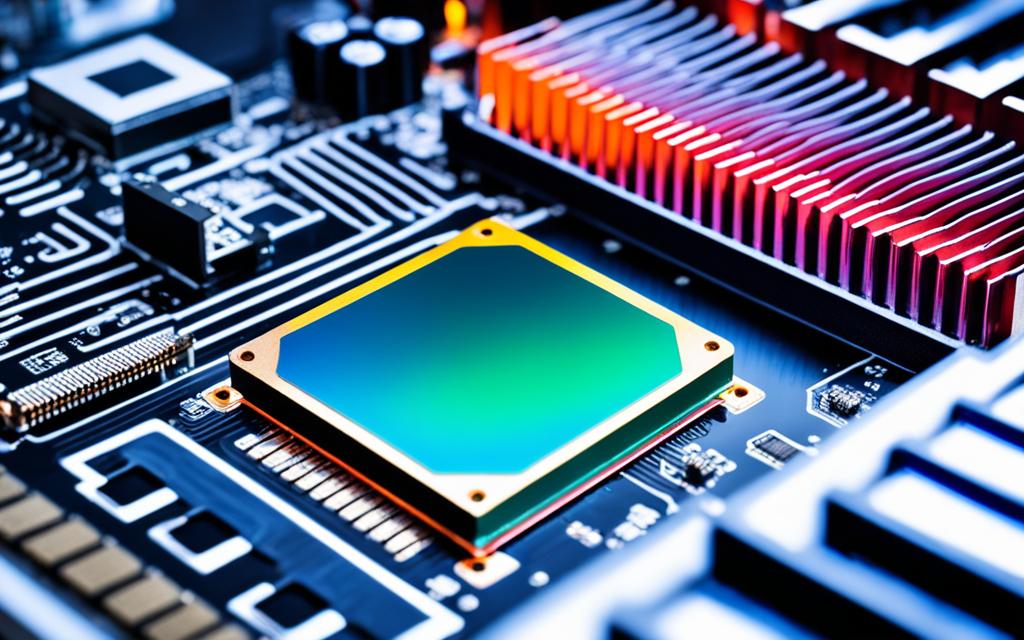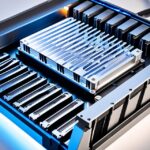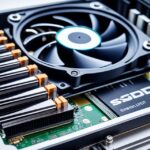Table of Contents
The need for more data storage means we must keep SSDs (solid-state drives) working well. A heatsink helps to keep the drive cool, but many don’t know if it’s needed. SSDs are made to work fine without one, but heat can shorten their life and lower their performance. This piece looks at if using a heatsink could make your SSD last longer and work better. This is crucial for gamers or those who move a lot of data around. For tips on boosting your PC, see this guide on fitting SSDs.
Key Takeaways
- SSDs get hot, which can change how well they work and last.
- A heatsink helps get rid of heat, really useful when pushing your PC hard.
- Check your motherboard’s ability to handle heat before getting a heatsink.
- Top NVMe SSDs from brands like Crucial and CORSAIR might need extra cooling for the best performance.
- Think about how you use your SSD to decide if a heatsink is needed.
Understanding SSDs and Heat Generation
Understanding how NVMe SSDs work and their heat generation is key to optimising their performance. These drives have a complex design with several essential parts. This affects their efficiency and how much heat they produce. We will look into the parts that make up NVMe SSDs and why they tend to get hot.
The Components of NVMe SSDs
NVMe SSDs are made up of three main parts: the controller chip, DRAM, and NAND flash memory. The controller chip acts like a brain, managing data commands to make operations smooth. DRAM is used for quick access to often-used data. NAND flash stores data permanently. Together, these parts allow SSDs to process and store data fast and efficiently.
Why SSDs Heat Up
When doing heavy tasks like moving big files or using complex programs, NVMe SSDs work hard and get hot. This heat comes from the controller chip working overtime and the constant reading and writing to the NAND flash. Also, because these drives operate quickly, especially M.2 SSDs that use PCIe Gen 4, they produce more heat than older drives. It’s important to manage this heat well to keep performance high and avoid slowdowns, especially when gaming or editing videos12.
Heat Management in SSDs
Keeping SSDs cool is crucial for their best performance. Too much heat can lead to slower speeds due to thermal throttling. This is a safety feature to avoid hardware damage3. Hence, it’s important to know how heat and performance are linked, especially if you use your device for tasks that need fast data handling.
How Heat Affects Performance
Heat can greatly impact how well SSDs work. For instance, Crucial SSDs are made to work best between 0 to 70 °C (32 to 158 °F)4. It’s key to keep an eye on the temperature, especially when it often goes over 65°C (149°F), as this can harm its performance4. Using heatsinks can really help improve how NVMe SSDs function. Many new motherboards already have ways to cool down M.2 SSDs to keep them running smoothly5.
The Throttling Mechanism of SSD Controllers
When SSDs get too hot, they slow down to prevent damage. This slowing down affects the SSD’s ability to quickly handle data, which is not ideal for gaming or other demanding applications3. Imagine an NVMe SSD at 70°C. With the right airflow and an 8 mm heatsink, it can cool down by 12°C. This makes data processing more efficient3. It shows why having good cooling solutions for SSDs is crucial for tackling heat issues.
Do You Need a Heatsink for SSD?
Whether you need a SSD heatsink depends on what you use your computer for. Everyday tasks like surfing the web or using office apps usually don’t make a SSD hot enough to need extra cooling. But, if you’re into heavy duty tasks like video editing or high-end gaming, your SSD might get too hot. This could slow down its performance, making a heatsink a good idea.
When Heatsinks are Beneficial
Newer SSDs, especially those with PCIe 4.0 and 5.0 tech, often need a heatsink. Studies show PCIe 4.0 NVMe drives generally need one to keep cool under intense use6. PCIe 5.0 drives also usually need a heatsink because they work even harder6. But, older PCIe 3.0 models might only need a heatsink on their control chip, if at all6.
Typical User vs Professional Use Cases
When you’re moving lots of data non-stop or playing high-end games, a heatsink is essential. A good heatsink helps keep SSDs in their ideal temperature range, which is between 0 to 70 °C4. If your SSD’s temperature often goes over 65°C, a heatsink can prevent it from overheating4. Nowadays, as tasks get more demanding and data is accessed quickly, even regular users can see a performance boost from using a heatsink.
| SSD Type | Performance Requirement | Heatsink Necessity |
|---|---|---|
| PCIe 3.0 | Standard tasks | Optional |
| PCIe 4.0 | High performance | Highly recommended |
| PCIe 5.0 | Intensive workloads | Essential |
Choosing whether or not to use a heatsink should be based on your specific computing needs. For professionals who often transfer data at high speeds, a reliable cooling solution is key. This helps prevent your SSD from failing or losing performance over time.
“For optimal performance, SSD heatsinks are not merely ornamental; they play a vital role in the reliability and longevity of your drives.”
Many modern motherboards come with built-in cooling solutions. This might mean you don’t need an extra heatsink for your SSD5. The best way to ensure your SSD performs at its peak is by understanding your computer’s hardware and how you use it.
Role of Heatsinks in Gaming Consoles
In the gaming world, good cooling is key for the best performance. Sony’s PS5 SSD needs the right setup to stay cool. It’s advised to use a heatsink with an M.2 SSD. This keeps overheating at bay during heavy gaming7.
PS5 SSD Installation Requirements
It’s important to follow specific steps when adding an SSD to your PS5. The console has a special slot for SSDs up to 4TB. These must match speed and size guidelines. Having a heatsink with your SSD is crucial for top performance. It helps manage heat, especially for larger SSDs, enhancing their function8.
Recommended SSDs with Heatsinks for PS5
Choosing the best SSD can boost your gaming experience. The Crucial T700 and Kingston FURY Renegade are great choices. They have built-in heatsinks. These SSDs meet PS5’s requirements and offer more storage. They also keep performance smooth and cool. For serious gaming, consider SSDs with heatsinks. They’re more reliable in the long run7.See what gamers suggest for more advice
Cooling Solutions for SSDs
Keeping SSDs cool is key for top performance and long life. Knowing the difference between passive and active cooling helps choose the best system.
Passive Cooling vs Active Cooling
Passive cooling uses heatsinks to spread and release heat. It’s quiet and easy to maintain. Active cooling uses fans to control heat. It can be noisy and needs regular care.
The Functionality of Heatsinks
Heatsinks are important for removing heat from SSDs. They pull heat away, improving performance and preventing damage. Some parts of an SSD like it warm, others do better cool. It’s important to keep this balance9.
Good heatsinks, like ID-Cooling M05 or M15, cost between $4.99 and $9.99. They protect your SSD well without being too big. The M15 even has a copper pipe for better heat spread. This is key for demanding games or work. Without cooling, a PCIe 5.0 SSD can lose almost all its speed in heat, showing why cooling matters10.
Thermal pads from companies like 3M or Rathbun also help control heat. They keep the controller cool, which is crucial under heavy use. As SSDs work hard, they get hotter. Keeping them cool keeps them working well and for longer11.
Choosing the Right SSD for Your Needs
When picking an SSD, it’s important to consider a few key factors for the best experience. A major aspect is whether the SSD has heatsinks to manage its temperature effectively. Heatsinks help keep the drive cool, but their effectiveness can vary based on what you use the SSD for.
When Built-in Heatsinks are Sufficient
For typical tasks done by most users, built-in heatsinks are usually good enough. Many NVMe SSDs fit in a small space and spread out heat well. They work so well even under tough tasks without extra cooling12. Yet, they can get really hot, sometimes over 80°C when pushed hard13. So, it’s key to know if your everyday work might make the SSD too hot. Knowing how much performance you need helps you figure out if you need more cooling.
Evaluating Your Setup’s Airflow
Good airflow is crucial for keeping your SSD at its best. A well-ventilated setup helps the heatsinks work better, making the drive cooler and longer-lasting. Putting NVMe SSDs in spots with direct airflow from case fans keeps them safe from overheating13. If your system allows air to reach the SSD easily, you might not need extra cooling. By checking the airflow and temperature around your SSD, you can make the most of its built-in cooling.
Conclusion
Understanding your system’s details is key to getting the most out of solid-state drives. Not all M.2 NVMe SSDs need a heatsink. But knowing when you need one can make your SSD last longer. Faster drives get hot, so managing heat helps avoid slowing down and data loss.
For gamers or those using high-demand apps, heatsinks are vital. Tests, like those with the Sabrent M.2 2280 SSD Rocket Heatsink, show cooling can drop temperatures by up to 25 degrees. This happens when using the Asus Maximus Z690 Apex M.2 heatsink14. Good cooling boosts performance and makes your SSD more reliable and long-lasting. This is crucial in our digital world.
It’s important to check what your SSD and setup need. The right cooling, active or passive, can hugely improve your SSD’s efficiency and your system’s overall performance. It also stops overheating. If you want to enhance your SSD’s cooling, discover the best heatsink options here141516.
FAQ
Why is a heatsink important for SSDs?
A heatsink is crucial for SSDs because it carries away heat during data transfers. This keeps the drive performing well and lasting longer. Without it, heat could slow down transfer rates to avoid damage.
Do all SSDs require a heatsink?
Not every SSD needs a heatsink. Users with typical computer tasks might not see too much heat. But those who game or do heavy tasks will find a heatsink very helpful.
How does heat affect SSD performance?
Heat greatly reduces how well an SSD works. If it gets too hot, it will slow down to stay safe. This slowdown can hurt performance, especially in demanding programs.
What are the cooling options for SSDs?
SSDs can be cooled in two main ways: passive and active. Passive cooling uses heatsinks to silently draw away heat. Active cooling uses fans to move heat away but can be noisy.
What qualifications should I look for in an SSD for gaming?
For gaming SSDs, effective cooling is key. Choose ones with heatsinks, especially if they are for the PlayStation 5. They should fit well and manage heat effectively.
How can I determine if my SSD needs a heatsink?
Think about how much you use your SSD and for what. A heatsink is a good idea for heavy tasks like video editing or advanced gaming to boost performance.
What role do built-in heatsinks play in SSD management?
Built-in heatsinks manage heat well for most uses. Check how well air moves around your setup to see if that’s enough for your SSD.
Source Links
- https://www.kingston.com/en/blog/gaming/playstation-5-heatsink-ssd-explained – PlayStation 5 and Heatsink SSDs Explained
- https://blog.westerndigital.com/ssd-heatsink-hot-storage-cool-data-m2/ – SSD Heatsink: Hot Data, Cool Storage
- https://www.atpinc.com/de/about/stories/overcoming-nvme-thermal-throttling-temperature – NVMe SSD Thermal Management: What We Have Learned from Marathons
- https://www.crucial.com/articles/about-ssd/do-you-need-an-nvme-ssd-heatsink – Do you need an NVMe SSD heatsink?
- https://www.corsair.com/us/en/explorer/diy-builder/storage/is-cooling-necessary-for-an-m2-nvme-ssd/ – Do you need to cool your M.2 NVMe SSD?
- https://forum.level1techs.com/t/are-nvme-heatsinks-worth-it-990-pro/202418 – Are NVMe Heatsinks Worth It? (990 Pro)
- https://www.techradar.com/news/ps5-ssd-heatsink-explained-what-is-it-for-and-do-you-really-need-one – PS5 SSD heatsink explained: what is it for and do you really need one?
- https://www.makeuseof.com/what-is-m2-nvme-ssd-heatsink/ – What Is an M.2 NVMe SSD Heatsink?
- https://community.frame.work/t/are-ssd-heatsinks-worth-it-or-a-waste/27525 – Are SSD Heatsinks worth it or a waste?
- https://www.tomshardware.com/pc-components/storage/id-cooling-zero-m05-and-m15-review – We tested 30 m.2 SSD heatsinks to find the top performer: ID-Cooling Zero M05 and M15 Review
- https://www.rathbun.com/ssd-cooling-solutions – SSD Cooling Material |Thermal Cooling Solutions
- https://www.digitaltrends.com/computing/ssd-buying-guide/ – SSD buying guide: how to pick the right SSD in 2023 | Digital Trends
- https://www.maketecheasier.com/does-nvme-ssd-need-heatsink/ – Tested: Does Your M.2 NVMe SSD Need a Heatsink?
- https://www.guru3d.com/review/guru3d-nvme-thermal-test/page-14/ – Guru3D NVMe Thermal Test – the heatsink vs. performance (Page 14)
- https://www.tomshardware.com/features/ps5-ssd-upgrade-temperature-testing – PS5 SSD Upgrade Temperature Testing: Do You Even Need a Heatsink?
- https://www.sbpcmechanic.com/nvme-ssds-the-need-for-heatsinks-and-optimal-temperature-range/ – NVMe SSDs: The Need for Heatsinks and Optimal Temperature Range – Santa Barbara Computer Repair “PC Mechanic” | Data Recovery








